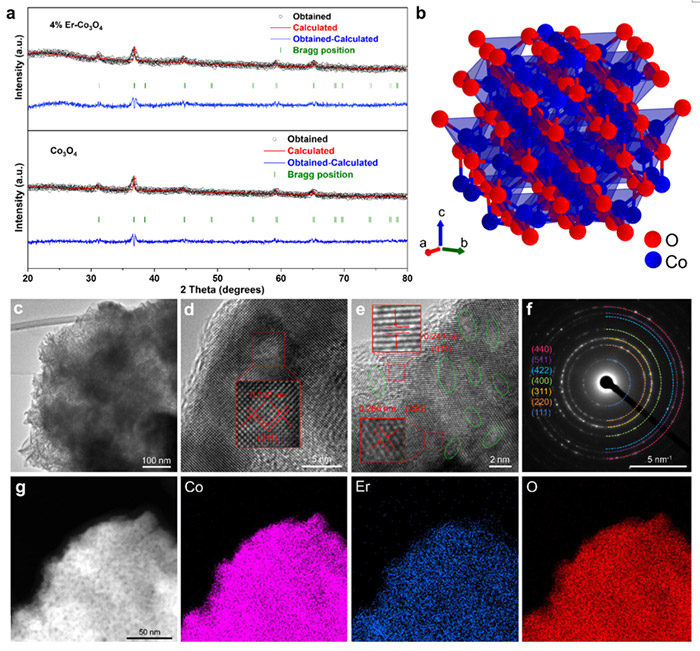

A group of researchers has developed a groundbreaking electrocatalyst that promises to significantly enhance the efficiency and stability of oxygen evolution reactions (OER) in acidic environments. By incorporating a rare earth element, erbium (Er), into the commonly studied cobalt oxide (Co3O4) catalyst, the team has demonstrated a new, cost-effective solution that surpasses the performance of many precious metal-free catalysts, offering an alternative to more expensive noble metal-based options.
Details of the findings were published in the journal ACS Catalysis, where the study was also selected as the Editors’ Choice.
The oxygen evolution reaction, a critical process in water splitting and energy conversion, requires robust and efficient catalysts, especially in acidic conditions. Traditionally, cobalt-based catalysts have shown moderate performance due to their spinel crystal structure, which provides stability and catalytic activity. However, the introduction of Er into the Co3O4 catalyst marks a significant leap forward.
“Our research shows that by doping a small amount of erbium into Co3O4, we can enhance both the activity and stability of the catalyst,” says Tianyi Wang, a JSPS postdoctoral researcher at Tohoku University’s Advanced Institute for Materials Research (WPI-AIMR), and co-author of the paper. “The 4% Er-doped Co3O4 catalyst we developed achieved an impressive overpotential of just 321 mV at 10 mA cm2 and maintained stability for over 250 hours. This performance is comparable to, and in some cases better than, more expensive iridium-based catalysts.”

Structural characterizations for the as-prepared catalysts. (a) XRD patterns of the Co3O4 and 4% Er−Co3O4. (b) Crystal structure of the Co3O4 in this study. (c) TEM image of 4% Er− Co3O4, (d-e) HRTEM images of (d) Co3O4 and (e) 4% Er− Co3O4 (green ellipse represents the lattice defects). (f) SAED pattern of 4% Er− Co3O4. (g) Dark-field TEM image and the corresponding elemental mappings of Co, Er, and O in the 4% Er− Co3O4. ©Hao Li et al.
The team employed advanced techniques, such as microkinetic modeling and density functional theory (DFT) calculations, to understand why this doped catalyst performs so well. The incorporation of Er led to the formation of more active sites and defects in the crystal structure, which in turn increased the ratio of Co3+ to Co2+ ions. This shift plays a key role in generating oxygen vacancies, crucial for accelerating the OER process.
“Imagine the catalyst like a road,” explains Hao Li, associate professor at WPI-AIMR and co-author of the paper. “The Er doping essentially adds extra lanes, allowing more traffic to move through smoothly. In this case, the traffic is the oxygen intermediates needed for the reaction. The increased number of oxygen vacancies act as these extra lanes, speeding up the reaction.”

Evaluation of electrochemical OER activity. (a) LSV curves of different catalysts at 1 mV/s scan rate and negative scan after iR correction. (b) Tafel plots of 4% Er–Co3O4, ErCoO3, and Co3O4. (c) EIS Nyquist plots of 4% Er–Co3O4, ErCoO3, and Co3O4 at 1.333 V (set potential). The inset shows the equivalent circuit (Rs series resistance; Rct charge transfer resistance). (d) TOF bar graph (based on current density at the iR-corrected overpotential of 430 mV). (e) Fitting plots show the Cdl values for 4% Er–Co3O4, ErCoO3, and Co3O4. (f) Chronopotentiograms of 4% Er–Co3O4 and Co3O4 at 10 mA cm–2. ©Hao Li et al.
Additionally, in situ Raman spectroscopy revealed that the oxygen vacancies created by the Er doping were located in the octahedral sites of the Co3O4 structure. These vacancies facilitated the development of critical intermediate species, which are essential for driving the OER process. The higher Co3+/Co2+ ratio further enhanced the catalytic activity by providing more active Co3+ sites to anchor these intermediates.
“This combination of electronic and structural optimization is really what makes the catalyst stand out,” adds Wang. “It’s the balance between these two factors that allows us to achieve such high performance.”
This research opens new possibilities for the design of high-performance catalysts that are both cost-effective and sustainable. Moving forward, the researchers plan to focus more on non-precious metal doping to design high-performance, low-cost and readily available electrocatalysts.

Theoretical analyses of the OER active phase and activity of Er-doped Co3O4 surfaces. (a) Calculated 1D surface Pourbaix diagram. (b) Calculated 2D surface Pourbaix diagram. (c) Microkinetic OER activity volcano model at 10 mA cm−2 as a function of GO-GHO. The theoretical predictions of FeNi-Ni, FeNi-Fe, and CoO were obtained from the existing literature Inset shows the identified surface coverage of Er−Co3O4 (311) under OER operating conditions. The Er, Co, and O are indicated as green, purple, and red, respectively. ©Hao Li et al.
| タイトル: | Er-Doping Enhances the Oxygen Evolution Performance of Cobalt Oxide in Acidic Medium. |
|---|---|
| 著者: | Sanjiang Pan, Hang Li, Tianyi Wang, Yang Fu, Shenao Wang, Zishuo Xie, Li Wei, Hao Li, and Nan Li |
| 掲載誌: | ACS Catalysis |
| DOI: | 10.1021/acscatal.4c03088 |
東北大学材料科学高等研究所(WPI-AIMR)
准教授 Hao Li(研究者プロフィール)
| E-mail: | li.hao.b8@tohoku.ac.jp |
|---|---|
| Webstie: | Hao Li Laboratory |
東北大学材料科学高等研究所(WPI-AIMR) 広報戦略室
| Tel: | 022-217-6146 |
|---|---|
| E-mail: | aimr-outreach@grp.tohoku.ac.jp |